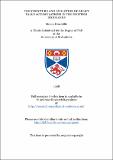Files in this item
The structure and evolution of relict talus accumulations in the Scottish Highlands
Item metadata
| dc.contributor.advisor | Ballantyne, Colin | |
| dc.contributor.advisor | Whittington, Graeme | |
| dc.contributor.author | Hinchliffe, Simon | |
| dc.coverage.spatial | 309 p. | en_US |
| dc.date.accessioned | 2018-07-10T15:35:47Z | |
| dc.date.available | 2018-07-10T15:35:47Z | |
| dc.date.issued | 1998 | |
| dc.identifier.uri | https://hdl.handle.net/10023/15206 | |
| dc.description.abstract | The aim of this thesis is to establish the evolutionary history of relict talus accumulations in the Scottish Highlands through study of their distribution, morphology, structure and sedimentology, and through dating and pollen analysis of buried soil horizons. Analyses of talus morphology demonstrates that though the investigated slopes comprise a basal concavity and upper straight slope, features hitherto interpreted as characteristic of unmodified rockfall accumulations, there is considerable variability in upper slope gradient. Surface relief indicates widespread reworking by slope failure, gullying and debris flows. Sections through gully-side exposures exhibit up to 3.5 m of stacked debris flow deposits, wash layers and buried soils overlying rockfall deposits, indicating a complex history of sediment reworking. Sedimentological analyses indicate that 27-30% of the talus sediments at one site (Trottemish) comprise fine (< 2 mm) particles representing granular weathering of the rockwall and syndepositional accumulation of both fine and coarse debris. The volume of talus on Trottemish implies an average rockwall retreat rate of c. 0.3 mm yr-1 since deglaciation, of which 0.08-0.09 mm yr-1 reflects granular weathering rather than rockfall. Failure and reworking of talus is inferred to reflect reduced infiltration rates (and high porewater pressures during rainstorms) caused by progressive accumulation of fines. Radiocarbon dating of buried soils indicates that reworking commenced prior to c. 6 cal ka BP, and has been intermittently active during the Holocene. Pollen analyses and charcoal concentration counts provide no evidence for accelerated reworking as a result of anthropogenic interference with vegetation cover, but the timing of reworking events provides support for enhanced activity associated with climatic deterioration after c. 2.7-2.3 cal ka BP. The characteristics of the investigated slopes show that models that treat talus as a free-draining accumulation of rockfall debris have limited applicability, and an alternative model that incorporates progressive reworking by other processes is proposed. | en_US |
| dc.language.iso | en | en_US |
| dc.publisher | University of St Andrews | |
| dc.subject.lcc | GB598.45H5 | en |
| dc.subject.lcsh | Geomorphology--Scotland | en |
| dc.title | The structure and evolution of relict talus accumulations in the Scottish Highlands | en_US |
| dc.type | Thesis | en_US |
| dc.contributor.sponsor | Natural Environment Research Council (NERC) | en_US |
| dc.type.qualificationlevel | Doctoral | en_US |
| dc.type.qualificationname | PhD Doctor of Philosophy | en_US |
| dc.publisher.institution | The University of St Andrews | en_US |
This item appears in the following Collection(s)
Items in the St Andrews Research Repository are protected by copyright, with all rights reserved, unless otherwise indicated.

